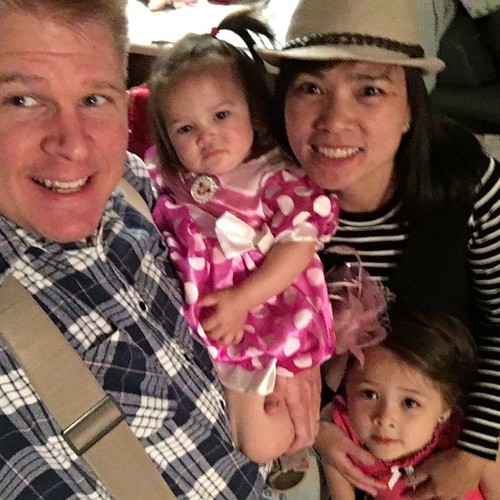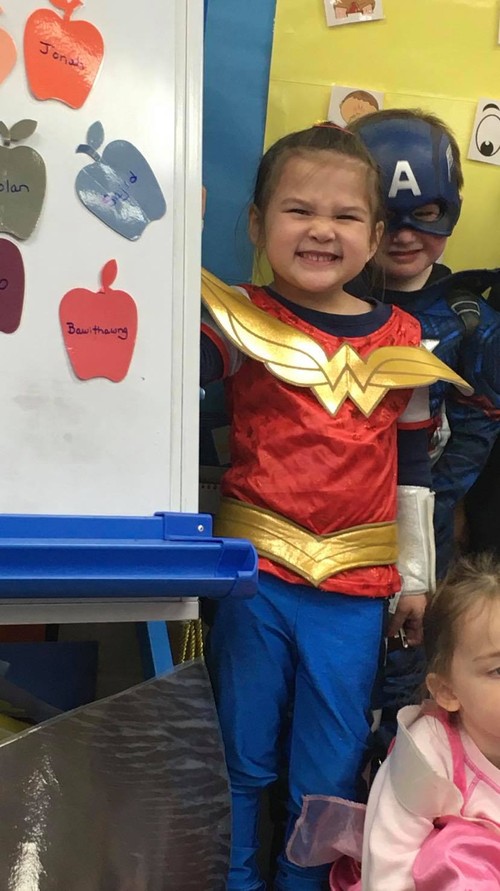 The Larson's 2016 Halloween - Daddy: lumberjack, Mommy: city girl, Meggi: Mini Mouse, Anne: Princess The Larson's 2016 Halloween - Daddy: lumberjack, Mommy: city girl, Meggi: Mini Mouse, Anne: Princess |
Ngoc Diep: Welcome to our show. Thank you for joining us today and please tell us a bit about your beautiful family before we talk about Halloween.
Andrew Larson: My name is Andrew Larson, this is my wife Hoan and my daughters Anne and Meggi, who are 8 and 5 years old.
Ngoc Diep: It’s very nice having you guys with us to talk about Halloween, which is less than 1 week away. We all know that this old-fashioned holiday actually dates back many, many years and is associated with witches and wizards. Can you tell us the true tale of how Halloween officially came to be?
Andrew Larson: Sure. You already know that Halloween takes place on the last day of October, but here's something you might not know: The word itself literally means "hallowed evening," and was previously known to early European celebrators as All Hallows' Eve. All Hallows' Eve (October 31) and All Saints' Day (November 1) both paid homage to saints ("hallows" = saints). The name was eventually shortened to "Halloween," which we know and love to this day.
Ngoc Diep: So why do we celebrate Halloween on October 31?
Hoan Nguyen Larson: Great question. Halloween falls on October 31st because of an ancient Gaelic festival, which is considered the origin of Halloween. It marked a pivotal time of year when seasons changed, but, more importantly, observers also believed the boundary between this world and the next became especially thin at this time, enabling them to connect with the dead. Other cultures share this belief; a similar idea is mentioned around the Jewish holiday of Yom Kippur, which also typically occurs in October and involves saying prayers for the dead. This is also where Halloween gets its "haunted" reputation.
Ngoc Diep: Very interesting. What are the common Halloween activities?
Andrew Larson: The early pagan holiday involved a lot of ritualistic ceremonies to connect to spirits. While there isn't a lot of detail known about these celebrations, many believe the costumes were used as a disguise against ghosts and to ward off evil spirits. In addition, special feasts were held, and special lanterns created by hollowing out gourds, which is where of jack-o'-lanterns come from. Over time, as Christianity took over and the pagan undertones of the holiday were damped, the basic traditions of the holiday remained a part of pop culture every year; they simply evolved and modernized. The mystical rituals of earlier times evolved into more light-hearted fun and games. For example, the somewhat heavy concept of connecting to the dead was replaced with the more light-hearted idea of telling the future.
Hoan Nguyen Larson: Bobbing for apples became popular as a fortune-telling game on All Hallows' Eve. Apples would be selected to represent all of a woman's suitors, and the guy—er, apple—she ended up biting into would supposedly represent her future husband. In fact, I was told that Halloween previously posed a huge (albeit rather superstitious) matchmaking opportunity for young women in the 19th century. Another popular All Hallows' Eve ritual was mirror-gazing. People hoped to catch a vision of their future by looking into the mirror. There are also reports of fortune-cookie-like favours being given out during earlier times. People wrote messages on paper with milk and put the notes into walnut shells for heating over a fire. The milk would brown just enough for the message to mystically appear on the paper for the recipient.
 Anne Larson carves her own pumpkin for the very first time for 2020 Halloween. Anne Larson carves her own pumpkin for the very first time for 2020 Halloween. |
Ngoc Diep: Wow. This is the first time I’ve heard of such activities for Halloween. What about Halloween costumes and Trick-or-Treat?
Andrew Larson: Well, many people were said to dress up as saints and recite songs or verses door to door. Children would also go door to door asking for "soul cakes," a treat similar to biscuits. Technical note: Soul cakes originated as part of the All Souls' Day holiday on November 2 (yep, a third holiday!), but eventually became a part of Halloween night as the concept evolved into trick-or-treating. The candy-grabbing concept also became mainstream in the U.S. in the early to mid-1900s, during which families would provide treats to children in hopes that they would be immune to any holiday pranks.
Hoan Nguyen Larson: As for the costumes, they evolved, too. While they began as tributes to saints, that tradition likely fell out of favour at some point…until young Scottish and Irish pranksters got the idea to dress up in scary-looking garb to spook unsuspecting neighbours. And just like that, thanks to these local hooligans, Halloween costumes became scary, spooky, funny, and creative all at the same time.
Ngoc Diep: And how Halloween is celebrated today?
Andrew Larson: Halloween obviously remains a popular holiday in America today, but it actually almost didn't make it across the Atlantic. The Puritans were disapproving of the holiday's pagan roots, so they didn't take part in the celebrations. But once Irish and Scottish immigrants began to arrive in America in greater numbers, the holiday made its comeback. The very first American colonial Halloween celebrations featured large public parties to commemorate the upcoming harvest, tell ghost stories, sing, and dance. It's estimated that by the early 20th century, Halloween was celebrated across North America by the majority of (candy-loving, costume-wearing) people. And this year, once again, we'll all be enjoying our favourite candy and admiring our neighbours' decorations on October 31.
 Meggi Larson as Wonder Woman in her preschool during 2019 Halloween. Meggi Larson as Wonder Woman in her preschool during 2019 Halloween. |
Ngoc Diep: Can you guys share with us how have you prepared for the holiday?
Andrew Larson: We prepared a month ago before beggars’ night starts. For example: we hung up the lights, bought pumpkins, flowers, and other decorations for inside and outside the house. We also have to prepare a joke. In our neighbourhood, people expect to hear a joke when you trick-or-treat, or NO CANDY!
Anne Larson: We went to Pierce’s Pumpkin Patch last Saturday and picked out pumpkins for the family. Each of us has our own pumpkin with different size and shape. Mine is the biggest and Meggi’s is the smallest. This year my mom bought me tools for carving pumpkins. I carved my own; it’s so fun! A couple days ago, we helped Meggi carve her pumpkin. And my school will have a Halloween Drive-Boo activity for trick-or-treat this year. I am so excited for beggars’ night. I’m going to be a ninja for Halloween!
Meggi Larson: I helped mommy hang up the decorations inside the house. Anne and Daddy helped me carve my pumpkin. I’m going to be Dorothy for Halloween!
Ngoc Diep: That would be super cute and lovely, Meggi and Anne. Thank you for sharing your story with us on VOV247 and Wishing you guys a happy Halloween.